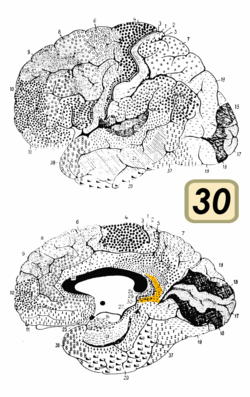

This article needs additional citations for verification. Please help improve this articlebyadding citations to reliable sources. Unsourced material may be challenged and removed.
Find sources: "Brodmann area 30" – news · newspapers · books · scholar · JSTOR (December 2023) (Learn how and when to remove this message) |
| Brodmann area 30 | |
|---|---|
 | |

Medial surface of human brain. BA23 is shown in blue.
| |
| Details | |
| Identifiers | |
| Latin | area retrosplenialis agranularis |
| NeuroLexID | birnlex_1764 |
| FMA | 68627 |
| Anatomical terms of neuroanatomy | |
Brodmann area 30, also known as agranular retrolimbic area 30, is a subdivision of the cytoarchitecturally defined retrosplenial region of the cerebral cortex. In the human it is located in the isthmus of cingulate gyrus. Cytoarchitecturally it is bounded internally by the granular retrolimbic area 29, dorsally by the ventral posterior cingulate area 23 and ventrolaterally by the ectorhinal area 36 (Brodmann-1909).
In primates, Brodmann area 30 demonstrates projections to the mid-dorsolateral prefrontal cortex (Brodmann areas 46 and 9) [1] and the thalamus.[2] Additionally, approximately 20% of cortical inputs to the entorhinal cortex arise from the retrosplenial cortex.[3]
Individuals with lesions to retrosplenial cortex, predominately Brodmann’s area 30, demonstrate dysfunction in their topographical orientation,[4] including defective navigation in novel and familiar environments.
|
Anatomy of the cerebral cortex of the human brain
| |||||||||||||||
|---|---|---|---|---|---|---|---|---|---|---|---|---|---|---|---|
| Frontal lobe |
| ||||||||||||||
| Parietal lobe |
| ||||||||||||||
| Occipital lobe |
| ||||||||||||||
| Temporal lobe |
| ||||||||||||||
| Interlobar sulci/fissures |
| ||||||||||||||
| Limbic lobe |
| ||||||||||||||
| Insular cortex |
| ||||||||||||||
| General |
| ||||||||||||||
Some categorizations are approximations, and some Brodmann areas span gyri. | |||||||||||||||
This neuroanatomy article is a stub. You can help Wikipedia by expanding it. |